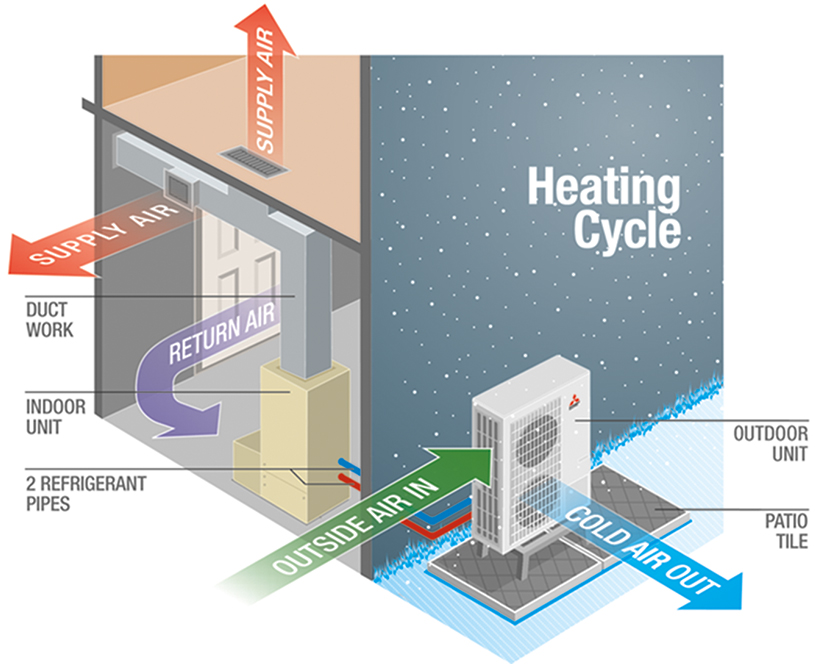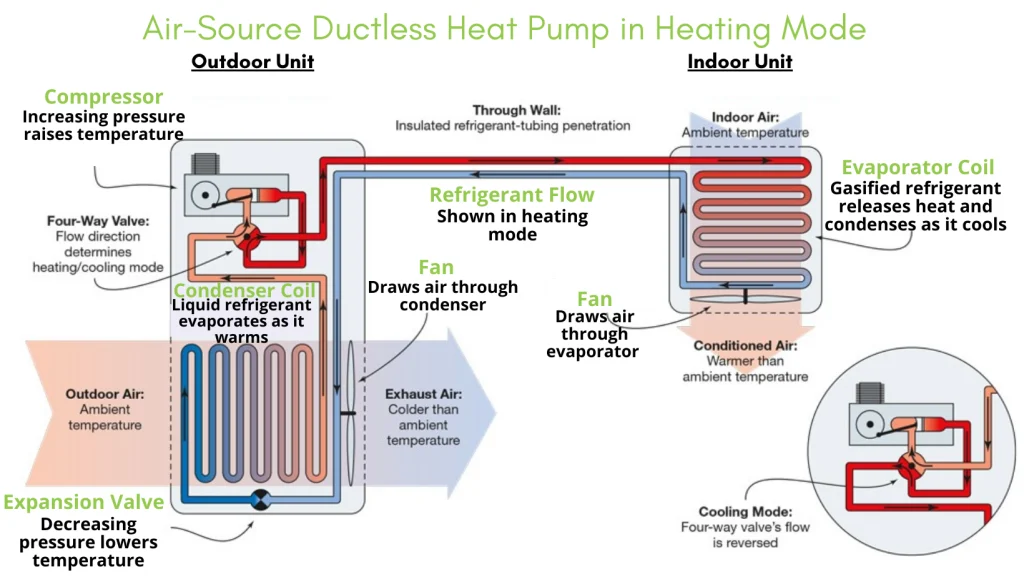Being the proud owner of an air source heat pump can significantly contribute to both energy efficiency and a climate-friendly home. However, things can turn south if you aren’t keeping up with regular maintenance to ensure your heat pump’s optimal performance. We’re big fans of do-it-yourself maintenance on your products in between professional servicing to keep your air source heat pump running in tip-top shape. Follow this simple DIY maintenance guide for your heat pump to get tips and tricks on self-maintenance for your heat pump, plus get a printable option for you to use whenever you need it, along with insights on when it’s time to call an expert.
Understanding Your Air Source Heat Pump:
Before we just jump into the how-tos on self-maintaining your heat pump, it’s super important to understand how the heat pump itself operates. Essentially, your air source heat pump works by transferring heat from the outside air into your home, and vice versa to cool it in the warmer months. It’s wild to know that there’s heat outside, even when temps are in the negatives, but it’s true! There are multiple parts that work to make all of this happen in your heat pump, including a compressor, condenser, evaporator, and refrigerant lines.
Tips for Heat Pump Self-Maintenance:
1 – Regularly Clean or Replace Air Filters:
One of the simplest yet most important maintenance tasks is cleaning or replacing your heat pump’s air filters. Clogged filters restrict airflow, reducing the heat pump’s efficiency and potentially leading to system malfunctions. Check your filters monthly and clean or replace them as needed, especially during peak usage seasons. Want to see filter cleaning in action? Check out our video on how to clean your wall-mounted heat pump air filters, or see our video on how to clean your mini-split ceiling-mounted heat pump air filters.
2 – Keep Outdoor Unit Clear:
The outdoor unit of your heat pump can accumulate dirt, debris, leaves, and even snow depending on the season. Make sure that the area around your heat pump’s outdoor unit remains clear to allow proper airflow. Trim back any growth from bushes, trees, or grass, and be sure to remove any obstructions that could block airflow to the unit.
3 – Inspect and Clean Coils:
Both your heat pump’s outdoor condenser coil and indoor evaporator coil can collect dirt and dust over time, hindering heat transfer. By periodically inspecting these coils and cleaning them, you’ll ensure efficient performance. For the outdoor unit, you can use a hose. Make sure you’re gentle to avoid damaging the fins. For the indoor unit, use a soft brush or vacuum cleaner.
4 – Check and Clean Drainage System:
A clogged condensate drain on your heat pump can cause water leakage or potentially even water damage to your home, and that’s no good! Inspect the condensate drain regularly and be sure to remove any obstructions using a vacuum or a mixture of water and mild detergent. Ensuring proper drainage prevents future issues.
5 – Monitor Refrigerant Levels:
While refrigerant leaks are very uncommon, it’s essential to monitor the refrigerant levels periodically to be sure nothing fishy’s happening with your heat pump. Low refrigerant levels may indicate a leak or other issues that require professional attention. If you notice a significant decrease in cooling or heating efficiency, contact the team at Elephant Energy to inspect and recharge the refrigerant as needed.
6 – Test Thermostat and Controls:
Regularly test your thermostat and heat pump controls to ensure they’re functioning correctly. Sometimes, it can be as simple as replacing the batteries in your thermostat if you’re having issues. You’ll also want to ensure that the settings are appropriate for your climate-friendly home’s needs.
7 – Lubricate Moving Parts:
Some components of your air source heat pump, such as fan motors and bearings, may require lubrication to reduce friction and ensure smooth operation. Refer to your owner’s manual for guidance on lubrication intervals and the type of lubricant to use.
Take a look at our best practices, FAQs, and troubleshooting tips for your heat pump from our team here:
– Mitsubishi Heat Pump User Guide
includes: Mitsubishi PUZ, Mitsubishi MXZ-SM/PVFY, Mitsubishi MXZ36-SVZ24, and Mitsubishi MXZ36
When to Call in the Experts:
While self-maintenance can help keep your air source heat pump in good condition, there are certain situations where professional assistance is necessary. Good news – we’re only a phone call or email away!
1 – Complex Repairs:
If you encounter any issues beyond basic maintenance tasks, such as compressor failure, refrigerant leaks, or electrical problems, it’s best to contact the team at Elephant, where we have qualified HVAC technicians ready to help. Attempting complex repairs without proper training and equipment can lead to further damage or safety hazards.
2 – Annual Professional Servicing:
We’re huge supporters of you performing DIY maintenance on your heat pump, but annual professional service can cover the more difficult and complex maintenance needs! During these service visits, a technician will conduct thorough inspections, tune-ups, and system diagnostics to ensure your heat pump is running at its best and proactively address any issues they may see with an expert eye.
3 – Warranty Coverage:
By installing your heat pump with Elephant Energy, you’ll automatically receive a one year warranty for labor. Our Mitsubishi heat pumps that we install also come with a 12- year manufacturer’s warranty. Plus, the Elephant Energy Maintenance + Extended Labor Warranty Packages are a great way to ensure the investment on your heat pump is well-maintained.

Following the manufacturer’s recommended maintenance guidelines while also relying on authorized service providers will preserve your warranty coverage. Remember – attempting large DIY repairs yourself or neglecting maintenance overall can void your warranty, so be sure you’re taking close care!
Maintaining your air source heat pump is crucial for maximizing its efficiency, lifespan, and performance. By following the tips and tricks outlined in this guide, you can perform basic maintenance tasks yourself and while keeping your heat pump running smoothly. However, remember to seek professional assistance for complex repairs and schedule annual servicing to address any underlying issues and ensure long-term reliability. With proper care and attention, your air source heat pump can continue to provide efficient heating and cooling for years to come.
–
Ready to get started? Join us in building a brighter future by electrifying everything, starting with homes. Your choice today shapes our collective tomorrow!

